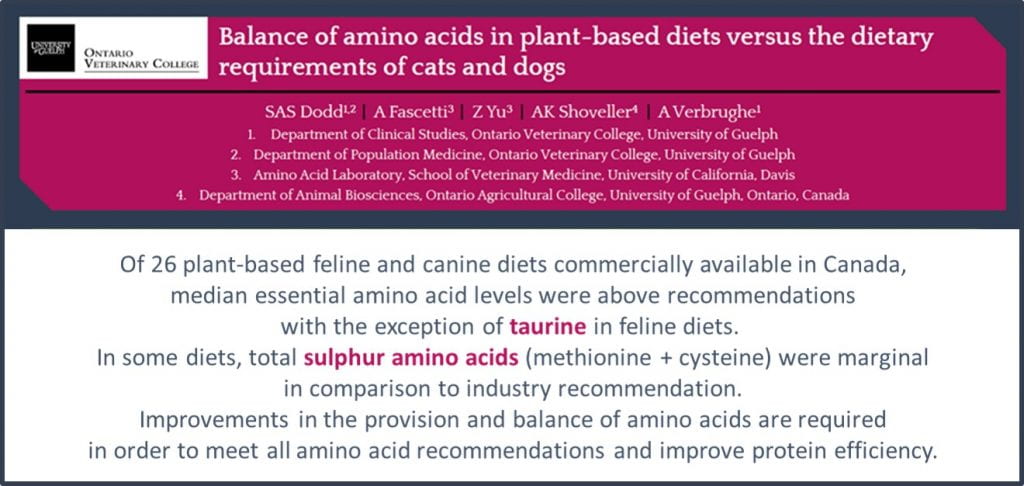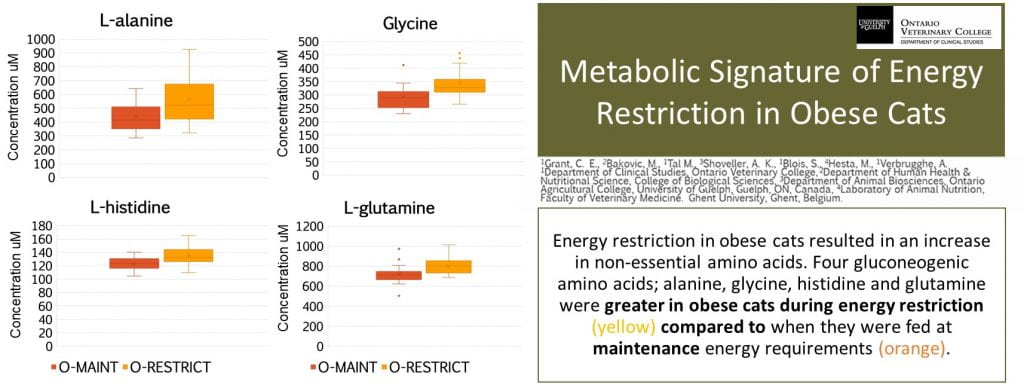2020 AAVN Clinical Nutrition and Research Symposium
Update from the OVC Pet Nutrition Team
From June 10th – 11th the American Academy of Veterinary Nutrition (AAVN) hosted its 20th annual meeting and first virtual AAVN Clinical Nutrition and Research Symposium. While the event was originally scheduled to be held in Baltimore (USA), the global pandemic with COVID-19 forced organizers to change to a virtual format. Fortunately, this did not detract from a great program with excellent research presented on a wide variety of topics: feeding methods in horses, renal care in senior cats, dietary interventions on the canine microbiome, and obesity prevention, treatment, and communication.
Three presentations were made by members of the OVC Nutrition Team: Dr. Sarah Dodd (PhD candidate and ECVCN resident), Dr. Caitlin Grant (DVSc candidate and ECVCN resident), and Hannah Godfrey (MSc student). As attendees and presenters, Sarah, Caitlin and Hannah have answered some questions for us to share their experiences at their first virtual symposium.
Tell us briefly about your presentation.
Sarah Dodd (SD): My poster presentation was on the provision of amino acids in plant-based pet foods.

Caitlin Grant (CG): In September 2019, I won the ESVCN-Waltham award at the Congress of the European Society of Veterinary and Comparative Nutrition (ESVCN), which took place in Italy. I was invited by the AAVN to repeat my talk, which focused on comparing the serum metabolomic profile of obese cats before and after weight loss.

Hannah Godfrey (HG): I presented my research project on choline supplementation and its effects on food intake and body composition in growing, post-gonadectomy kittens. This was my very first presentation at a major nutrition conference!

Do you have any thoughts on the virtual experience aspect of the conference? How does this compare to other presentations you have done in-person?
SD: I was very impressed by how smoothly the virtual conference went. I think the organizers did a great job, especially considering they had only a handful of weeks to change their format. There wasn’t as much time for answering questions for poster presentations, because usually people will come around and chat with you at your poster, whereas in the virtual event we only had a couple minutes per poster. I think a happy alternative would be if you ran a virtual poster session like they did, but also provided the contact details of the presenter so interested parties could email questions there wasn’t time to answer.
CG: I second Sarah’s comments about the amazing job of the organizers! I missed being able to see everyone in-person, and the social events at conferences are always a fun opportunity to reconnect with colleagues from all over the world. But it was exciting to see the number of people logged in to learn together, I think it reached 220 at one point! Also, I must be honest, it was a nice change to see the questions that I would be asked t in advance (in the chat box) so I could prepare answers and not be put on the spot!
HG: In agreement with everyone else–the organizers did an amazing job! This would have been my first time presenting at a conference, so I don’t have anything to compare it to. It was unfortunate not to meet and see people from other areas, but there were opportunities for discussion in the online chat forum. I have to say the online format and the way the organizers presented it took some of the nervousness out of presenting, which was a bonus for me!
Tell us about one presentation or poster that stuck out to you and why. What was a key take-away?
SD: Well, cannabidiol (CBD) has been such a hot topic, and the only paper I had seen regarding its use for pain management in dogs with arthritis was written by Dr. Joe Wakshlag, so having him present more background and newer research was great. I feel like I understand the nuances a lot better now, and while I still won’t be recommending CBD to any of my patients (it’s illegal for vets in Canada to do so), I would feel more comfortable doing so in the future if we are allowed – with my own caveats about monitoring liver parameters if dosing consecutively for more than a couple weeks.
CG: The presentation I really enjoyed was an abstract presentation on results from a survey about the habits of owners cleaning pet bowls; the researchers also tested some bowls for bacterial contamination. I thought this was interesting and something that every veterinary health care team should think about when making recommendations to owners. I honestly never thought about instructing owners to clean the bowls (I assumed that they did!) and didn’t know there were guidelines in place to follow. So, this will certainly add a new topic to my discussions with owners, and maybe change the way I wash my pet’s bowls too!
HG: There were some great presentations, but I have to say the one that stood out to me was “Applying human behavioural modification strategies in the management of pet obesity” by Dr. Sarah Colby. While it was focused on communicating about obesity to pet owners as a veterinarian, which is an area I won’t be finding myself in, I found she had some really great points that were also transferable to communicating scientific findings to the general population, which is definitely an area of interest to me. Obesity is a hot topic and people can develop some strong emotional opinions, so it is always important to be respectful and provide that safe space when communicating with people about these issues.
Attending a nutrition conference—whether in person or virtual—is always full of new lessons and this year’s AAVN Clinical Nutrition Symposium did not disappoint. Later this summer the OVC Nutrition team will be hosting and presenting research at the Global Animal Nutrition Summit so watch this space for more reports on exciting research findings!
Written by Hannah Godfrey, BScH, MSc Candidate


